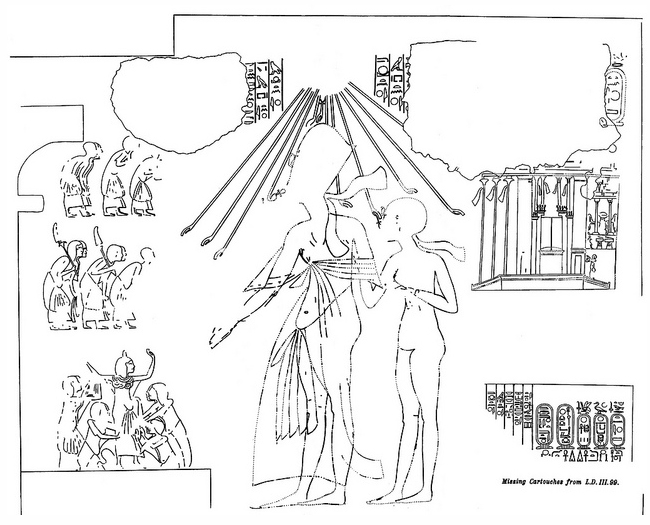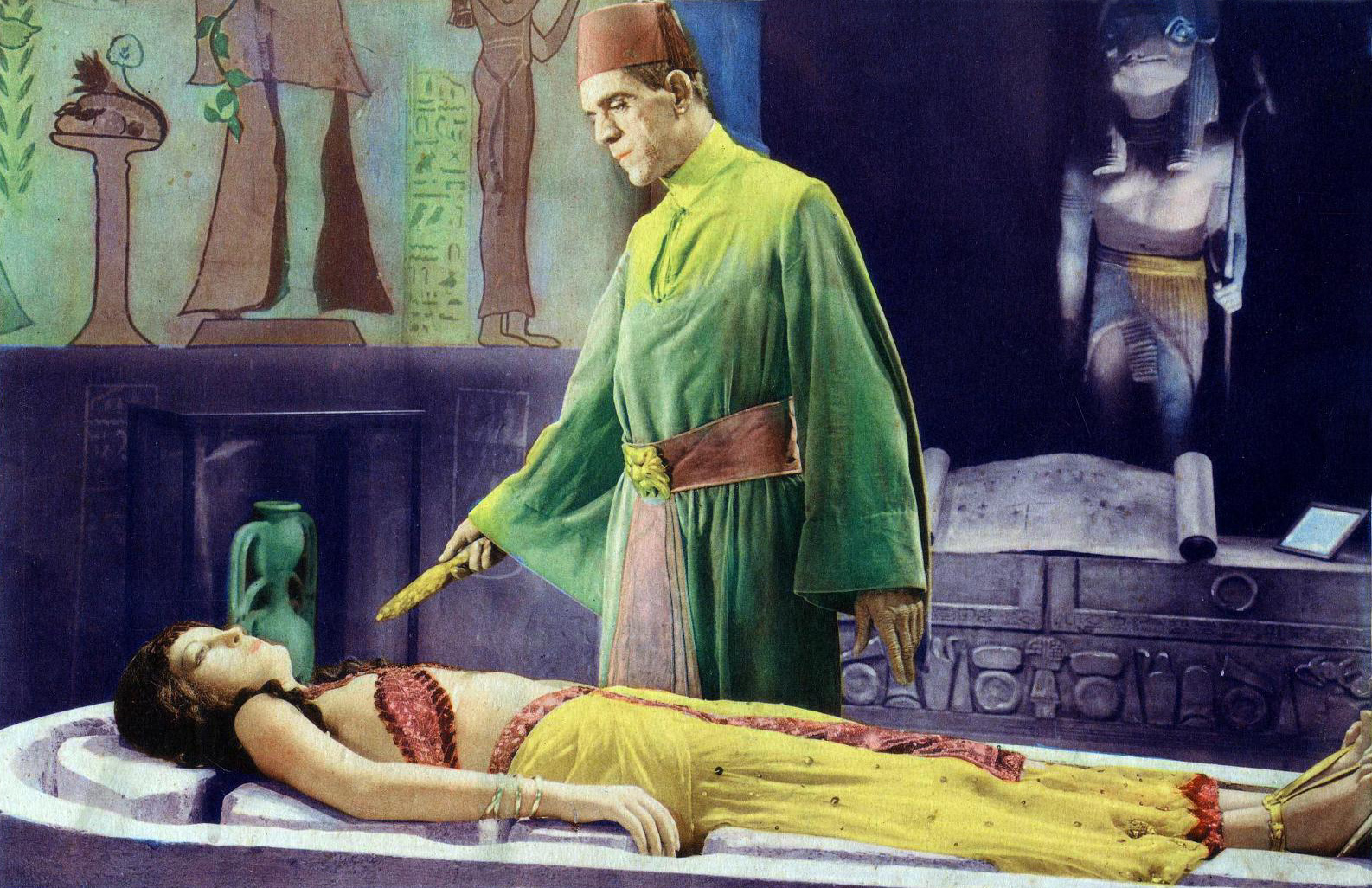|
Coregency Stela
The Coregency Stela is an ancient Egyptian stela dating from the late Eighteenth Dynasty of Egypt. It consists of seven limestone fragments, which were found in a tomb at Amarna. The tablet shows the figures of Akhenaten, Nefertiti, and Meritaten. At some time after the stela was made, Nefertiti's name had been chiselled out and was replaced with Ankhkheperure Neferneferuaten, the name of Akhenaten's co-regent. At the same time Meritaten's name was replaced with that of Ankhesenpaaten, Akhenaten and Nefertiti's third daughter. The stela might shed light on the events of the little-known late- Amarna Period and the question of Akhenaten's immediate succession. Restoration and interpretation of the stela vary, but it has been suggested that it supports the claim that Nefertiti should be identified as Akhenaten co-regent and successor. The stela is currently in the Petrie Museum in London London is the capital and List of urban areas in the United Kingdom, largest city of ... [...More Info...] [...Related Items...] OR: [Wikipedia] [Google] [Baidu] |
Stele
A stele ( ),Anglicized plural steles ( ); Greek plural stelai ( ), from Greek , ''stēlē''. The Greek plural is written , ''stēlai'', but this is only rarely encountered in English. or occasionally stela (plural ''stelas'' or ''stelæ''), when derived from Latin, is a stone or wooden slab, generally taller than it is wide, erected in the ancient world as a monument. The surface of the stele often has text, ornamentation, or both. These may be inscribed, carved in relief, or painted. Stelae were created for many reasons. Grave stelae were used for funerary or commemorative purposes. Stelae as slabs of stone would also be used as ancient Greek and Roman government notices or as boundary markers to mark borders or property lines. Stelae were occasionally erected as memorials to battles. For example, along with other memorials, there are more than half-a-dozen steles erected on the battlefield of Waterloo at the locations of notable actions by participants in battle. A traditio ... [...More Info...] [...Related Items...] OR: [Wikipedia] [Google] [Baidu] |
Limestone
Limestone ( calcium carbonate ) is a type of carbonate sedimentary rock which is the main source of the material lime. It is composed mostly of the minerals calcite and aragonite, which are different crystal forms of . Limestone forms when these minerals precipitate out of water containing dissolved calcium. This can take place through both biological and nonbiological processes, though biological processes, such as the accumulation of corals and shells in the sea, have likely been more important for the last 540 million years. Limestone often contains fossils which provide scientists with information on ancient environments and on the evolution of life. About 20% to 25% of sedimentary rock is carbonate rock, and most of this is limestone. The remaining carbonate rock is mostly dolomite, a closely related rock, which contains a high percentage of the mineral dolomite, . ''Magnesian limestone'' is an obsolete and poorly-defined term used variously for dolomite, for limes ... [...More Info...] [...Related Items...] OR: [Wikipedia] [Google] [Baidu] |
Amarna
Amarna (; ar, العمارنة, al-ʿamārnah) is an extensive Egyptian archaeological site containing the remains of what was the capital city of the late Eighteenth Dynasty. The city was established in 1346 BC, built at the direction of the Pharaoh Akhenaten, and abandoned shortly after his death in 1332 BC. The name that the ancient Egyptians used for the city is transliterated in English as Akhetaten or Akhetaton, meaning " the horizon of the Aten".David (1998), p. 125 The site is on the east bank of the Nile River, in what today is the Egyptian province of Minya. It is about south of the city of al-Minya, south of the Egyptian capital, Cairo, and north of Luxor (site of the previous capital, Thebes). The city of Deir Mawas lies directly to its west. On the east side of Amarna there are several modern villages, the chief of which are l-Till in the north and el-Hagg Qandil in the south. Activity in the region flourished from the Amarna Period until the later Roman era ... [...More Info...] [...Related Items...] OR: [Wikipedia] [Google] [Baidu] |
Akhenaten
Akhenaten (pronounced ), also spelled Echnaton, Akhenaton, ( egy, ꜣḫ-n-jtn ''ʾŪḫə-nə-yātəy'', , meaning "Effective for the Aten"), was an ancient Egyptian pharaoh reigning or 1351–1334 BC, the tenth ruler of the Eighteenth Dynasty. Before the fifth year of his reign, he was known as Amenhotep IV ( egy, jmn-ḥtp, links=no, meaning "Amun is satisfied", Hellenized as ''Amenophis IV''). As a pharaoh, Akhenaten is noted for abandoning Egypt's traditional polytheism and introducing Atenism, or worship centered around Aten. The views of Egyptologists differ as to whether the religious policy was absolutely monotheistic, or whether it was monolatry, syncretistic, or henotheistic. This culture shift away from traditional religion was reversed after his death. Akhenaten's monuments were dismantled and hidden, his statues were destroyed, and his name excluded from lists of rulers compiled by later pharaohs. Traditional religious practice was gradually restored, not ... [...More Info...] [...Related Items...] OR: [Wikipedia] [Google] [Baidu] |
Nefertiti
Neferneferuaten Nefertiti () ( – c. 1330 BC) was a queen of the 18th Dynasty of Ancient Egypt, the great royal wife of Pharaoh Akhenaten. Nefertiti and her husband were known for a radical change in national religious policy, in which they promoted a form of proto-monotheism centred on the sun god Aten. With her husband, she reigned at what was arguably the wealthiest period of ancient Egyptian history. Some scholars believe that Nefertiti ruled briefly as Neferneferuaten after her husband's death and before the ascension of Tutankhamun, although this identification is a matter of ongoing debate.Dodson, Aidan, Amarna Sunset: ''Nefertiti, Tutankhamun, Ay, Horemheb, and the Egyptian Counter-Reformation''. The American University in Cairo Press. 2009, . If Nefertiti did rule as Pharaoh, her reign was marked by the fall of Amarna and relocation of the capital back to the traditional city of Thebes. She was made famous by her bust, now in Berlin's Neues Museum. The ... [...More Info...] [...Related Items...] OR: [Wikipedia] [Google] [Baidu] |
Meritaten
Meritaten, also spelled Merytaten, Meritaton or Meryetaten ( egy, mrii.t-itn) (14th century BC), was an ancient Egyptian royal woman of the Eighteenth Dynasty of Egypt. Her name means "She who is beloved of Aten"; Aten being the sun-deity whom her father, Pharaoh Akhenaten, worshipped. She held several titles, performing official roles for her father and becoming the Great Royal Wife to Pharaoh Smenkhkare, who may have been a brother or son of Akhenaten. Meritaten also may have served as pharaoh in her own right under the name Ankhkheperure Neferneferuaten.J. Tyldesley, ''Chronicle of the Queens of Egypt'', 2006, Thames & Hudson, pg 136–137 Family Meritaten was the first of six daughters born to Pharaoh Akhenaten and his Great Royal Wife, Nefertiti. Her sisters are Meketaten, Ankhesenpaaten, Neferneferuaten Tasherit, Neferneferure, and Setepenre. Meritaten is mentioned in diplomatic letters, by the name ''Mayati''. She is mentioned in a letter from Abimilki of Tyre. The refe ... [...More Info...] [...Related Items...] OR: [Wikipedia] [Google] [Baidu] |
Smenkhkare
Smenkhkare (alternatively romanized ''Smenkhare'', ''Smenkare,'' or ''Smenkhkara''; meaning "'Vigorous is the Soul of Re") was an ancient Egyptian pharaoh of unknown background who lived and ruled during the Amarna Period of the 18th Dynasty. Smenkhkare was husband to Meritaten, the daughter of his likely co-regent, Akhenaten. Very little is known of Smenkhkare for certain because later kings sought to erase the Amarna Period from history. Because of this, perhaps no one from the Amarna Interlude has been the subject of so much speculation as Smenkhkare. Origin and family Smenkhkare's origins are unknown. It is assumed he was a member of the royal family, likely either a brother or son of the pharaoh Akhenaten. If he is Akhenaten's brother, his mother was likely either Tiye or Sitamun. If a son of Akhenaten, he was presumably an older brother of Tutankhamun, as he succeeded the throne ahead of him; his mother was likely an unknown, lesser wife. An alternative suggestion, base ... [...More Info...] [...Related Items...] OR: [Wikipedia] [Google] [Baidu] |
Coregency
A coregency is the situation where a monarchical position (such as prince, princess, king, queen, emperor or empress), normally held by only a single person, is held by two or more. It is to be distinguished from diarchies or duumvirates such as ancient Sparta and Rome. Co-principality is a distinct but related system employed in contemporary Andorra, where monarchical power is formally divided between two rulers. Historical examples Coregencies were common in the Hellenistic period; according to one scholar, they "can usually be explained as a means of avoiding crises of succession or internal conflict, and of strengthening dynastic identity and ideology." Other examples include the coregency of Frederick I of Austria and Louis the Bavarian over the Kingdom of Germany. ''Jure uxoris'' Kings in Kingdoms such as Spain and Portugal can also be found (Ferdinand V and Isabella I of Castile, Philip I and Joanna of Castile, Peter III and Maria I of Portugal, etc.). In Navarre, ... [...More Info...] [...Related Items...] OR: [Wikipedia] [Google] [Baidu] |
Ankhesenpaaten
Ankhesenamun (, "Her Life Is of Amun"; c. 1348 or c. 1342 – after 1322 BC) was a queen who lived during the 18th Dynasty of Egypt as the pharaoh Akhenaten's daughter and subsequently became the Great Royal Wife of pharaoh Tutankhamun. Born Ankhesenpaaten (, "she lives for the Aten"), she was the third of six known daughters of the Egyptian Pharaoh Akhenaten and his Great Royal Wife Nefertiti. She became the Great Royal Wife of Tutankhamun. The change in her name reflects the changes in ancient Egyptian religion during her lifetime after her father's death. Her youth is well documented in the ancient reliefs and paintings of the reign of her parents. The mummy of Tutankhamun's mother has been identified through DNA analysis as a full sister to his father, the unidentified mummy found in tomb KV55, and as a daughter of his grandfather, Amenhotep III. So far his mother's name is uncertain, but her mummy is known informally to scientists as the Younger Lady. Ankhesenamun was well ... [...More Info...] [...Related Items...] OR: [Wikipedia] [Google] [Baidu] |
Amarna Period
The Amarna Period was an era of History of Ancient Egypt, Egyptian history during the later half of the Eighteenth dynasty of Egypt, Eighteenth Dynasty when the royal residence of the pharaoh and his queen was shifted to Akhetaten ('Horizon of the Aten') in what is now Amarna. It was marked by the reign of Amenhotep IV, who changed his name to Akhenaten (1353–1336 BC) in order to reflect the dramatic change of Ancient Egyptian religion, Egypt's polytheistic religion into one where the sun disc Aten was worshipped over all other gods. The Egyptian pantheon was restored under Akhenaten's successor, Tutankhamun. Religious developments Akhenaten instigated the earliest verified expression of a form of monotheism, although the origins of a pure monotheism are the subject of continuing debate within the academic community. Some state that Akhenaten restored monotheism while others point out that he merely suppressed a dominant solar cult by the assertion of another, while never complet ... [...More Info...] [...Related Items...] OR: [Wikipedia] [Google] [Baidu] |





